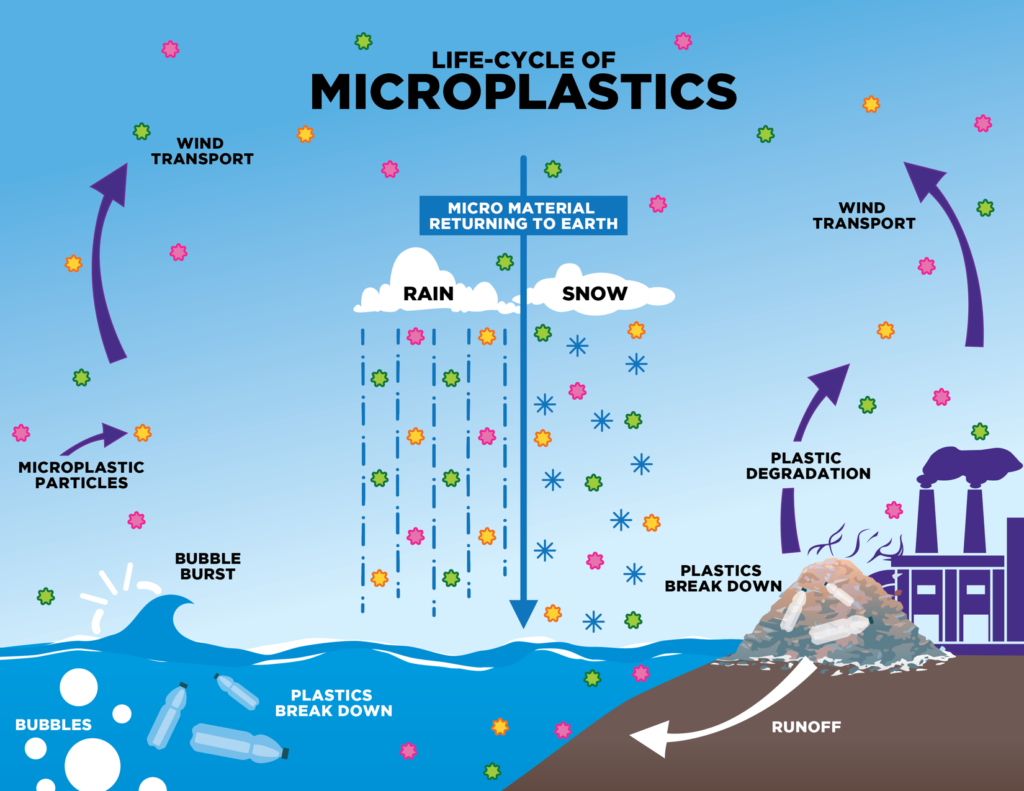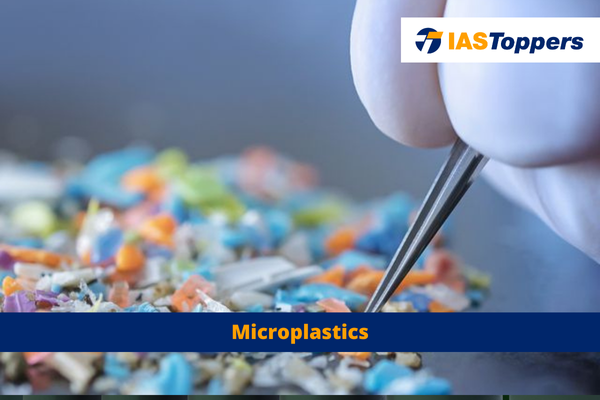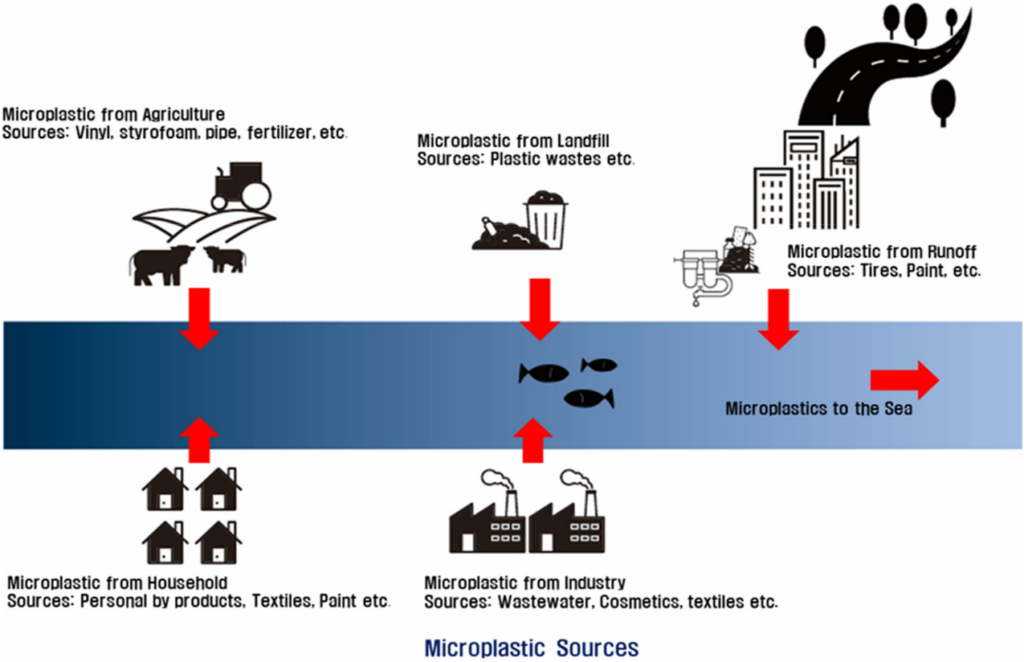Microplastics is a specific type of microplastic that consists of minuscule polyethylene plastic particles added to health and beauty products like cleansers and toothpastes for exfoliation. Microplastics have sizes with less than five millimetres. In this article, you will learn definition, origin, types, impacts, prevention, etc.
This article will provide key insights for GS Paper-III Environment, ecology and Disaster Management of UPSC IAS Exam.
Table of Content
- What is Microplastics?
- Origin of Microplastics
- Types of microplastics
- Where are microplastics been detected?
- Why are microplastics harmful?
- Prevention of microplastics
- Conclusion
- Frequently Asked Questions
- Reference
What is Microplastics?
- Microbeads is a specific type of microplastic that consists of minuscule polyethylene plastic particles added to health and beauty products like cleansers and toothpastes for exfoliation.
- Microplastics have sizes with less than five millimetres.
- In 2004, Professor Richard Thompson has introduced the term “microplastics.”
- The smallest microplastic detected in the oceans at present is 1.6 micrometres in diameter.
Origin of Microplastics:
- Microplastics originates from sources such as the gradual degradation of larger plastic debris into smaller fragments, the presence of resin pellets utilized in plastic production, or in the shape of microbeads.
- Microbeads is tiny manufactured plastic beads used in health and beauty products.
- The plastic microbeads in personal care products were started fifty years ago as plastics has replaced natural ingredients in various products.
- Microplastic fibres enter the environment through the washing of synthetic clothing, while tire erosion produces tiny plastic and rubber particles.
- More microplastics can be formed from biodegradable polymer than from non–biodegradable polymer in both seawater and fresh water.
- Marine debris such as those originating from fishing gear, fishing vessel, nylon netting, and marine industries.
- Sewage treatment plants also contains microplastics which is often used as soil fertilizer in some countries, which exposes plastics of the sludge to the biological factors, causing its fragmentation.
Types of microplastics
- There are two types of microplastics on the basis of its origin– primary and secondary.
Primary microplastics:
- Primary microplastics are manufactured small pieces of plastic in order to be used in various products, such as facial cleansers, cosmetics, and exfoliating hand cleansers.
- These microplastics have replaced traditionally used natural ingredients such as ground almond shells, oatmeal, and pumice.
- They can also be used as vectors for drugs in medicine or in air blasting technology for machinery maintenance.
Secondary microplastics:
- Secondary microplastics are derived from the breakdown of larger plastic debris through processes such as photo-oxidation through sunlight exposure or biological, and chemical degradation.
- Fragmentation of secondary microplastics occurs when large plastic materials is reduced to much smaller pieces over time.
Where are microplastics been detected?
- Microplastics can get accumulated in the air and in the ocean and terrestrial ecosystems.
- Though the full cycle and movement of microplastics in the environment are not yet fully understood.
- The microplastics is present in deposition layers much older than the invention of plastics.
- Microplastics have also been discovered in the high mountains, far from their original sources.
- Microplastics have been detected in human blood, but their specific effects on health is unknown.
- The Polybrominated Diphenyl Ethers (PBDEs) is a plastic-derived chemical which are found in the stomachs of short-tailed shearwaters.
- Some birds had higher-brominatedcongeners that are not naturally found in their prey, but it had entered their body due to plastics.
- Thus, not only plastics are transferred through the food chain but the chemicals from the plastics are also transferred.

Why are microplastics harmful?
- Microplastics cause pollution when it enters natural ecosystems from sources such as cosmetics, clothing, food packaging, plastic bottle and industrial processes.
- These tiny particles can then bypass water filtration systems, ultimately finding their way into the oceans and lakes, posing potential risks to marine life.
- Due to the slow degradation of plastics, which can take hundreds to thousands of years, for degradation microplastics can be ingested, incorporated, and accumulated in the bodies and tissues of various organisms.
- Microplastics gets embedded in animals’ tissue through ingestion or respiration.
Impacts on marine life:
- Marine life often suffers from entanglement, ingestion, suffocation and debilitation leading to death or strandings from such microplastics.
- Microplastics are mistaken by fish as food, which when ingested can block their digestive tracts sending incorrect feeding signals to the brains of the animals.
- Enmeshment of the microplastics in gills of fish can prevent elimination entirely.
- The toxic chemicals present in the ocean and runoff can also bio magnify plastics in the food chain.
- Zooplankton often ingest microplastics beads and excrete fecal matter contaminated with it.
- Along with ingestion, the microplastics stick to their appendages and exoskeleton.
- Some microbes often live on the surface of microplastics by forming a biofilm which provides a novel habitat for colonization that increases overlap between different species.
- This can lead to spread of pathogens and antibiotic resistant genes through horizontal gene transfer from their origin to another location where a specific pathogen may not be naturally present.
Impacts on human and terrestrial animals:
- In terrestrial ecosystems, microplastics negatively impacts soil ecosystems and reduce the weight of earthworms.
- Microplastics might serve as vectors for pathogens or biochemically harmful substances to enter into the body of an organism including humans.
Prevention of microplastics:
- Plastics can be incinerated in order to be used as energy through process known as energyrecovery.
- However, as opposed to recycling, this method does not diminish the amount of plastic material that is produced.
- Biodegradation: it is the process in which microplastics when consumed and decomposed by microorganisms into synthetic polymers by means of enzymes.
- These microbes could potentially treat sewage wastewater, which would decrease the amount of microplastics that pass through into the surrounding environments.
- The collection devices placed nearer to the coasts can remove the microplastics in the area.
- Increasing awareness through recycling is one of the solutions for microplastic contamination.
- Also, circular economy is one of the viable solutions.
- The Clean Oceans Initiative is a project launched in 2018 that provides up to €2 billion in lending, grants and technical assistance until 2023 to develop projects that remove pollution from waterways.
Conclusion
In the narrative of India’s fight for environmental sustainability, a new challenge emerges – microplastics. These insidious pollutants, plastic fragments less than 5 millimeters in size, contaminate our ecosystems and pose a potential threat to human health. Understanding their source, impact, and potential solutions becomes crucial for policymakers navigating this uncharted territory.
Ref: Source-1
| Other Articles in Environment & Disaster Management | |
| Ocean Acidification | Central Pollution Control Board (CPCB) |
| Plastic Waste Management | World Meteorological Organization |
| Bonn Convention (Convention on Migratory Species (CMS)) | National Green Tribunal |
FAQs (Frequently Asked Questions)
Are microplastics harmful to humans?
Microplastics can affect the human body by stimulating the release of endocrine disruptors and it might serve as vectors for pathogens or biochemically harmful substances to enter into the body.
What is the biggest source of microplastics?
Synthetic fabrics are the biggest source of microplastics.
What are 2 sources of microplastics?
Microplastics come from synthetic textiles, city dust, tires, road markings, marine coatings, personal care products and engineered plastic pellets.







